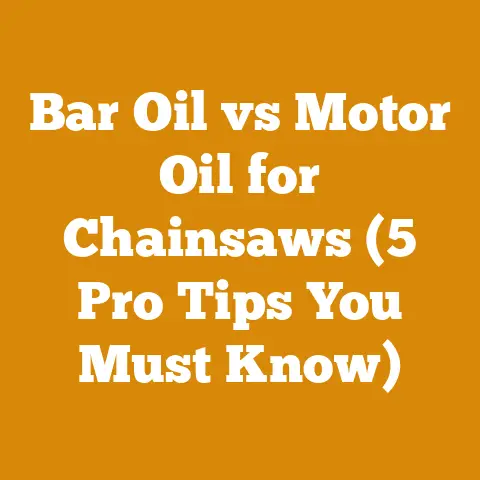Used Oil Pump Guide (5 Expert Tips for Efficient Waste Oil Transfer)
Ever find yourself wrestling with a stubborn drum of used oil, wishing there was an easier, cleaner way to transfer it? I know I have. As someone who’s spent years knee-deep in sawdust and the satisfying scent of freshly cut wood, I’ve learned that proper waste oil management isn’t just about environmental responsibility; it’s about efficiency, safety, and, frankly, saving yourself a whole lot of mess. Let’s dive into the world of used oil pumps and how to choose the right one for your needs.
1. Understanding Your Needs: The Foundation of Pump Selection
Before you even think about buying a pump, you need a clear picture of your specific needs. This isn’t a one-size-fits-all situation. The right pump for a small workshop handling a few gallons of oil a month will be vastly different from the right pump for a large logging operation dealing with hundreds of gallons weekly.
Assessing Volume and Frequency
First, consider the volume of used oil you generate and how frequently you need to transfer it. Do you need to move 5 gallons a week, or 50? Are you transferring oil daily, weekly, or monthly?
Data Point: According to the EPA, improper disposal of even one gallon of used oil can contaminate up to one million gallons of fresh water. This statistic alone highlights the importance of efficient and safe oil transfer.
Viscosity Considerations
The viscosity of your used oil is another crucial factor. Used motor oil, for example, tends to be thicker than hydraulic oil, especially in colder temperatures. A pump that works perfectly for thin fluids might struggle with thicker, more viscous oils.
My Experience: I once tried using a low-powered pump designed for water to transfer used gear oil in the dead of winter. It was a disaster! The pump strained, sputtered, and barely moved any oil. I quickly learned that the pump’s flow rate and pressure capabilities need to match the oil’s viscosity.
Lift Height and Distance
Consider the lift height (how high the oil needs to be pumped) and the horizontal distance the oil needs to travel. A pump with insufficient power will struggle to move oil over long distances or up steep inclines.
Tip: Check the pump’s specifications for maximum lift height and flow rate at different distances. These figures will give you a good indication of the pump’s capabilities.
Power Source Availability
Think about your power source. Do you have access to compressed air, electricity, or do you need a manual pump? Air-powered pumps are great for high-volume applications but require an air compressor. Electric pumps are convenient but need a reliable power source. Manual pumps are ideal for remote locations or situations where power isn’t available.
2. Types of Used Oil Pumps: Choosing the Right Tool for the Job
Once you understand your needs, you can start exploring the different types of used oil pumps available. Each type has its advantages and disadvantages, so it’s important to choose the one that best fits your requirements.
Manual Pumps
Manual pumps are the simplest and most affordable option. They’re ideal for low-volume applications and situations where power isn’t available. They typically use a lever or handle to create suction and move the oil.
Pros:
- Affordable
- Portable
- No power required
- Simple to operate
Cons:
- Slow
- Requires manual effort
- Not suitable for high-volume applications
Example: A rotary hand pump is a common type of manual pump. It’s great for transferring small amounts of oil from a drum to a smaller container.
Air-Operated Diaphragm Pumps
Air-operated diaphragm pumps (AODD) are powered by compressed air. They’re more expensive than manual pumps but offer significantly higher flow rates and can handle thicker fluids.
Pros:
- High flow rates
- Can handle viscous fluids
- Self-priming
- Relatively portable
Cons:
- Requires an air compressor
- Can be noisy
- More expensive than manual pumps
Data Point: AODD pumps can typically transfer oil at rates of 5 to 50 gallons per minute, depending on the model and air pressure.
My Experience: I switched to an AODD pump for my sawmill operation, and it was a game-changer. It significantly reduced the time it took to transfer used hydraulic oil, and it handled the thick oil without any issues.
Electric Pumps
Electric pumps are another popular option. They offer a good balance of flow rate, convenience, and cost. They’re available in various types, including gear pumps, centrifugal pumps, and submersible pumps.
Pros:
- Convenient to use
- Good flow rates
- Relatively quiet
- Available in various types
Cons:
- Requires a power source
- Can be more expensive than manual pumps
- Some types are not suitable for viscous fluids
Example: A gear pump is a good choice for transferring used motor oil. It can handle the viscosity and provides a consistent flow rate.
Submersible Pumps
Submersible pumps are designed to be placed directly into the oil drum or container. They’re ideal for situations where you need to pump oil from the bottom of a tank or drum.
Pros:
- Easy to use
- Self-priming
- Can pump oil from the bottom of a container
Cons:
- Requires a power source
- Can be difficult to clean
- Not suitable for all types of oil
3. Key Features to Look For: Ensuring Performance and Durability
Once you’ve narrowed down the type of pump you need, it’s time to focus on specific features that will ensure performance and durability.
Flow Rate and Pressure
The flow rate (measured in gallons per minute or liters per minute) and pressure (measured in PSI or bar) are crucial specifications. Make sure the pump can deliver the flow rate and pressure you need for your application.
Tip: Don’t just look at the maximum flow rate. Check the flow rate at different pressure levels. A pump might have a high maximum flow rate, but it could drop significantly at higher pressures.
Material Compatibility
The pump’s material must be compatible with used oil. Some materials can corrode or degrade when exposed to oil, leading to pump failure.
Common Materials:
- Cast Iron: Durable and affordable but can corrode over time.
- Stainless Steel: Corrosion-resistant and ideal for harsh environments but more expensive.
- Polypropylene: Lightweight and chemical-resistant but not as durable as metal.
My Experience: I learned the hard way about material compatibility. I used a pump with rubber seals that weren’t designed for used oil, and the seals quickly deteriorated, causing leaks and pump failure.
Seal Quality
The seals are critical for preventing leaks. Look for pumps with high-quality seals made from materials like Viton or Teflon, which are resistant to oil and chemicals.
Port Size and Type
The port size and type should match your hoses and fittings. Common port sizes include 1/2 inch, 3/4 inch, and 1 inch. Common port types include NPT (National Pipe Thread) and BSP (British Standard Pipe).
Tip: Use thread sealant when connecting hoses and fittings to prevent leaks.
Self-Priming Capability
A self-priming pump can draw oil without needing to be manually primed. This feature is especially useful if the pump is located above the oil source.
Bypass Valve
A bypass valve prevents the pump from overheating or being damaged if the outlet is blocked. This is an important safety feature, especially for electric and air-operated pumps.
Filtration
Some pumps come with built-in filters to remove debris from the oil. This can help extend the life of the pump and prevent contamination of the oil.
4. Installation and Operation: Setting Up for Success
Proper installation and operation are essential for maximizing the performance and lifespan of your used oil pump.
Mounting
Mount the pump securely to a stable surface. This will prevent vibrations and movement, which can damage the pump and hoses.
Hoses and Fittings
Use high-quality hoses and fittings that are designed for oil transfer. Make sure the hoses are the correct length and diameter for your application. Avoid sharp bends in the hoses, as this can restrict flow.
Tip: Use clamps to secure the hoses to the fittings. This will prevent leaks and ensure a tight connection.
Electrical Connections (for Electric Pumps)
If you’re using an electric pump, make sure the electrical connections are properly grounded and protected from moisture. Use a GFCI (Ground Fault Circuit Interrupter) outlet to prevent electrical shock.
Air Connections (for Air-Operated Pumps)
If you’re using an air-operated pump, make sure the air compressor is properly sized for the pump. Use an air filter and regulator to ensure clean, consistent air pressure.
Data Point: Most AODD pumps require an air pressure of 40 to 100 PSI for optimal performance.
Priming (if Required)
If your pump isn’t self-priming, you’ll need to prime it before each use. This typically involves filling the pump housing with oil to create suction.
Operation
Follow the manufacturer’s instructions for operating the pump. Avoid running the pump dry, as this can damage the internal components. Monitor the pump for leaks, unusual noises, or vibrations.
My Experience: I once forgot to prime my pump before starting it, and it ran dry for several minutes. The pump overheated, and the seals were damaged. I learned my lesson the hard way!
5. Maintenance and Safety: Protecting Your Investment and Yourself
Regular maintenance and adherence to safety precautions are crucial for extending the life of your used oil pump and protecting yourself from injury.
Cleaning
Clean the pump regularly to remove dirt, debris, and oil residue. This will prevent clogs and ensure optimal performance.
Tip: Use a solvent or degreaser to clean the pump. Make sure the solvent is compatible with the pump’s materials.
Lubrication
Lubricate the pump’s moving parts according to the manufacturer’s instructions. This will reduce friction and wear.
Seal Inspection
Inspect the seals regularly for cracks, leaks, or deterioration. Replace worn seals promptly to prevent oil leaks.
Hose Inspection
Inspect the hoses regularly for cracks, kinks, or damage. Replace damaged hoses immediately.
Storage
Store the pump in a clean, dry place when not in use. This will protect it from corrosion and damage.
Safety Precautions
- Wear safety glasses and gloves when handling used oil.
- Work in a well-ventilated area to avoid inhaling fumes.
- Clean up spills immediately to prevent slips and falls.
- Dispose of used oil properly according to local regulations.
- Never smoke or use open flames near used oil.
- Disconnect the pump from the power source before performing maintenance.
Data Point: According to OSHA, slips, trips, and falls are among the most common workplace injuries. Cleaning up oil spills promptly can significantly reduce the risk of these injuries.
My Personal Story: I once had a close call when a hose burst while I was transferring used oil. The oil sprayed all over me, and I was lucky to escape without any serious injuries. From that day on, I always wear safety glasses and gloves when handling used oil, and I inspect my hoses regularly.
Wood Science: Understanding the Impact on Oil Usage
Understanding the properties of the wood you’re processing directly affects your equipment maintenance, and thus, your oil usage. Hardwoods, like oak and maple, are denser and require more force to cut, leading to higher wear and tear on chainsaws and other tools. This increased wear results in more frequent oil changes and higher oil consumption.
Softwoods, such as pine and fir, are less dense and easier to cut, but they can be more resinous. The resin can gum up the saw chain and other components, requiring more frequent cleaning and lubrication.
Data Point: Studies have shown that processing hardwoods can increase chainsaw chain wear by up to 30% compared to processing softwoods.
Moisture Content Dynamics
The moisture content of the wood also plays a significant role. Green wood (freshly cut) has a high moisture content, which can help lubricate the saw chain and reduce friction. However, it also increases the risk of rust and corrosion on the equipment. Dry wood, on the other hand, is more abrasive and can cause the saw chain to dull more quickly.
Tip: Adjust your oiling frequency and type based on the type and moisture content of the wood you’re processing.
Logging Tool Selection and Maintenance Best Practices
Choosing the right logging tools and maintaining them properly can significantly reduce your oil consumption and extend the life of your equipment.
Chainsaw Selection
When selecting a chainsaw, consider the size and type of wood you’ll be cutting. A larger chainsaw with a more powerful engine will be more efficient for felling large trees, while a smaller chainsaw will be more maneuverable for limbing and bucking.
Tip: Choose a chainsaw with an adjustable oiler. This will allow you to control the amount of oil being delivered to the chain, reducing waste and ensuring optimal lubrication.
Chainsaw Chain Maintenance
Proper chain maintenance is essential for efficient cutting and reduced oil consumption. Keep the chain sharp and properly tensioned. Sharpen the chain regularly using a file or chain grinder.
Data Point: A sharp chainsaw chain can cut up to 20% faster than a dull chain, reducing fuel consumption and oil usage.
Bar Maintenance
Clean the chainsaw bar regularly to remove dirt, sawdust, and resin. Check the bar for wear and damage. Replace the bar if it’s bent, cracked, or excessively worn.
Tip: Rotate the bar regularly to distribute wear evenly.
Firewood Seasoning Techniques and Safety Considerations
Properly seasoned firewood burns more efficiently and produces less smoke. This reduces the need for frequent chimney cleaning and reduces the risk of chimney fires.
Seasoning Process
Seasoning firewood involves drying it to reduce its moisture content. This can be done by stacking the wood in a sunny, well-ventilated area for several months.
Tip: Split the wood before seasoning it. This will increase the surface area and allow it to dry more quickly.
Stacking Techniques
Stack the firewood in a way that allows air to circulate freely. Leave space between the rows and layers of wood.
Data Point: Firewood should have a moisture content of 20% or less for optimal burning.
Safety Considerations
- Wear safety glasses and gloves when handling firewood.
- Stack the firewood in a stable manner to prevent it from falling.
- Keep the firewood away from flammable materials.
- Inspect your chimney regularly for creosote buildup.
Project Planning and Execution
Planning your wood processing or firewood preparation projects carefully can help you optimize your oil usage and reduce waste.
Project Assessment
Before starting a project, assess the scope of the work and the resources you’ll need. This will help you avoid unnecessary trips and reduce fuel consumption.
Equipment Preparation
Make sure your equipment is in good working order before starting a project. This will prevent breakdowns and delays.
Waste Management
Plan for the proper disposal of waste oil and other materials. This will help you protect the environment and comply with local regulations.
Final Thoughts: Optimizing Your Oil Usage
By understanding your needs, choosing the right pump, and following these tips for installation, operation, maintenance, and safety, you can significantly improve the efficiency of your used oil transfer process. Remember, proper waste oil management is not just about environmental responsibility; it’s about saving time, money, and hassle. Now, go forth and conquer those oil drums!






